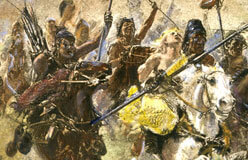The power of the Roman Empire came from its large, well-trained army. Roman soldiers made conquest possible. Equally important, once lands were captured, troops kept conquered peoples under control and protected the empire’s borders.
Roman soldiers were busy. When they weren’t fighting, they were building forts and bridges, supervising in mines and quarries, standing guard duty, or working on road repairs. And when they weren’t doing any of these jobs, they were probably marching. Many days they hiked 20 miles carrying backpacks weighing over 60 pounds.
In the first century A.D., about 150,000 Roman citizens and 150,000 noncitizens served in the army. Most were volunteers. A Roman soldier was called a legionary because the army was divided into large units called legions. For training and fighting, each legion was split into smaller groups, called centuries, of 80 men each. Their commanders were centurions. Poor men often chose a military career because it offered meals, good pay, and the chance to learn a trade. But getting into the army was a lot easier than getting out, because soldiers served a 25-year stint.







